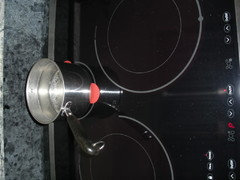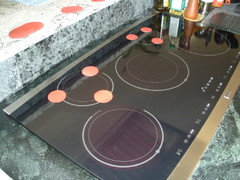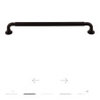kas - use of silpat on induction cooktop?
Kas,
In the past you have mentioned that you use a silpat to protect the surface of your cooktop. Is the silicone affected by high heat cooking?
We just got our cooktop installed a couple of days ago. I put two large Roul'Pats on the surface. Roul'Pats are similar to Silpats, only they have silicone on both surfaces. Where we have used high heat, the mat is discolored by the bottom of the pans. Has this happen to you? I assume the pans are getting over the limit that silicone can withstand - around 500 degrees, I believe.
Thanks,
Cheryl
Comments (24)
jadeite
Original Author11 years agoI didn't realize you weren't using silpat sheets across the entire element. Going with small pieces makes the problem simpler. Is the small clearance sufficient that you don't have scratches on the cooktop?
I've found a source of 1/8" silicone rubber sheet, supposedly high temperature (525 degrees). I could cut that into smallish squares and use them around the element. It's not too expensive as a experiment.
Another (related) question: I've looked at the induction disks which are basically aluminium surrounded by ferromagnetic steel. This seems unnecessarily inefficient to me. Cooks Illustrated compared the time to boil water with this disk and the time with straight induction, and the time with the disk was twice as long.
It seems to me that you could use a thin plate of galvanized steel over the induction element. It should heat up, turning it into a radiant element. If you use an aluminium (or copper, or other nonmagnetic but thermally conductive material) pot on top, I think you would get heating at higher efficiency. It's basically the same as stainless cookware with steel/aluminium/steel base. What do you think?
I understand the steel plate would be very hot, but no more than the existing cookware. DH tells me the edges could be smoothed out so it wouldn't be dangerous.
Cheryl
Related Professionals
Bonita Kitchen & Bathroom Designers · East Islip Kitchen & Bathroom Designers · United States Kitchen & Bathroom Designers · Williamstown Kitchen & Bathroom Designers · Cherry Hill Kitchen & Bathroom Designers · Feasterville Trevose Kitchen & Bathroom Remodelers · Apex Kitchen & Bathroom Remodelers · Glen Carbon Kitchen & Bathroom Remodelers · Salinas Kitchen & Bathroom Remodelers · Ridgefield Park Kitchen & Bathroom Remodelers · Alton Cabinets & Cabinetry · Avocado Heights Cabinets & Cabinetry · Highland Village Cabinets & Cabinetry · Holt Cabinets & Cabinetry · Middletown Cabinets & Cabinetryweedmeister
11 years ago"What do you think?"
I think the thermal conductivity between the two non-bonded metals would not be that good. I would not waste my time with it. If I wanted a radiant cooktop, I'd go buy one.
The only danger with using a silicon matte is getting it so hot that it melts. Then it is next to impossible to chisel off the glass.
jadeite
Original Author11 years agoThe cost of a carbon steel plate to fit over the element is under $15. On top of it I would have my Calphalon pot which is constructed of an excellent conductor. No, it wouldn't be bonded, but the miniscule air gap will make little difference to thermal conduction. I think it's worth a cheap experiment to see if it works or not. I can't see a downside.
I bought an induction cooktop but I have a LOT of anodized aluminium cookware, including some pieces which would be expensive or hard to replace. Yes, I have induction-ready cookware, but if I can use my 12 qt Calphalon braisier with a cheap plate, why not?
kaseki
11 years agoThe silicone sheet I use is closer to 1/16 inch. An eighth should still work; I don't think many field lines will sneak under the pan.
Conduction between a pan and an induction disk will be improved if both are very flat and smooth.
It seems to me that the better approach would be to put a disk of susceptible stainless steel inside the pot to be induction heated. The pot bottom would have to be relatively thin, such as exemplified by Revereware. (Note: some ancient Revereware is susceptible and works on induction.)
I fear that in order to get reasonable response, users will heat the induction disks to a temperature hotter than the pan would be heated for whatever cooking was in use. The temperature might exceed the ceram top limit, although one hopes in that case that the hob shuts down.
The thermal mass of the disk may also degrade the induction advantage (over coils) of rapid thermal response.
kas
jadeite
Original Author11 years agoKas - I can find 1/16" silicon, or 1/32", but at some point isn't there danger of the material tearing?
Why would you prefer stainless over carbon which is a better thermal conductor?
I think a metal sheet, with very small thermal mass would be more efficient than the disks. You can get carbon steel in very thin sheets. I don't know how well galvanized steel would hold up to high heat, I'd be afraid the coating might come off.
The cooktop shuts down if the temperature exceeds 1000F (or thereabouts). While I'm intrigued by the notion of this experiment, I'm too cowardly to play around with temperatures this high.
carolml
11 years agokas,
I have been reading this post with interest as I have never heard of using silicone pads on induction. Have I got this right? - you place three small 1/16" silicone pads around each burner you use. I presume this is to protect the ceramic cook top from scratching. Are there other reasons? Could you explain further, for the non technical?
Thank you.kaseki
11 years agoThe idea of a stainless steel disk was that it wouldn't react with the contents of the pot or pan it was put into. I wasn't recommending it for under the pan. 'Twas a mere speculation.
OK, on silicone sheet. I used to buy sheets from whatever sources I could find on the web or mall. Sooner or later someone would ruin the middle part from walking away from a pan on high. (This wouldn't be me of course.) It occurred to me that smaller pieces would allow me to utilize the still good outer corners and allow me to see the lines for hob alignment. So I used some templates (old cans) to cut out circular pieces (because they look better than random shapes). I use three per pan. I have 1.5 inch circles for the smallest hob, and larger circles for larger pans used on larger hobs. They are easily cleaned.
The silicone pads perform two services. One, the pans are off the ceram, reducing scratching, including the potential of micro-scratching that boiling water could induce by vibrating the pan.
A second benefit is easier cleaning of spills. The temperature of the ceram at a hob is determined by how much heat conducts or radiates from the pan to the ceram. With spacing by silicone pad, or better by an air gap using a tripod of pads, the temperature is minimized and the already greatly improved cleanability of the surface due to induction is further improved because the ceram may not be hot enough to burn the spill.
After boiling eggs for 9 minutes on my smallest hob, the ceram is too hot to keep one's hand on it, but it won't crisp one's skin as a radiant surface would.
kas
carolml
11 years agoThanks kas. I'll have my induction top in a couple of months and look forward to experimenting.
Carolattofarad
11 years agokas,
Maybe you can experiment some time with boiling water. No pad, full pad 1/16", full pad 1/8", etc. It would be interesting to know how much speed is lost by increasing the air gap (well, non-ferrous gap). There also is some heat loss in your "tripod" pad vs. continuous, but that has to be pretty small.
jadeite
Original Author11 years agoattofarad - I plan to do something like this once I get my silicon rubber sheet. But I have boiled water using my Roul'Pat and I can tell you it's PDQ.
BTW I got the Thermador with sensordome, mainly because I found it at a great price. No sensor strips were in the box, but Thermador says they will send. Once I've gotten some experience with the cooktop, I'll post a full review. I bought Thermador in part based on your positive comments.
Cheryl
kaseki
11 years agoattofarad:
My time for new experiments is probably measured in zepto seconds, but I'll try to fit it in. Defining a boil got a few hot under the collar, as I recall in some other thread, so I need to decide what that is. Also, equalized starting conditions need to be carefully planned.
There could also be a difference in field line compression between the thin 404 (probably) Revere Ware I use for egg boiling and thicker bases such as All Clad/Emeril Ware/etc.
My belief, however, is that the boiling time difference between no pad and a 1/16 pad will be very slight, if measurable, and the difference between a tripod of small pads vs. one large pad will be unmeasurable. I expect the tripod air gap to only affect the temperature of the ceram surface under the pot.
kas
lalithar
11 years agoKas,
I am very curious about this.. Can you please post a photo of our set up? Why do ou do this.. Is this to make cleanup easy?
kaseki
11 years agoLalitha:
I'll try to take a photo soon. Getting it on-line may be delayed depending on how annoying the process is.
Advantages include scratch avoidance, ease of clean-up, and reduced heating of the ceram surface.
kas
kaseki
11 years agoTime consuming, if not annoying. Here are some photos of the silicon pads as I presently use them.



kas
JXBrown (Sunset 24, N San Diego County)
11 years agoI installed a Kenmore Elite induction cooktop.in December 2005. I have yet to scratch the glass although the stainless steel frame has developed quite a bit of "patina". Glass is very hard to scratch. I don't do anything special to protect or clean it.
kaseki
11 years agojxbrown:
Mine came with a blurb marked "Euro Kera Vitroceramique" describing the eponymously named surface material as a "glass ceramic." The blurb included instructions for when special cleaning and protection were called for.
Whether vitroceramic or glass, it would still be susceptible to scratching from minerals with a higher Moh's number hardness, and various harder metals and ceramics. Keeping it perfectly clean and never dragging a pan can avoid scratching.
I applaud your success so far in cooking directly on it for 6.5 years without inducing any scratches.
kas
JXBrown (Sunset 24, N San Diego County)
11 years agoKas
You have a lovely set up there. However, in my experience the induction cooktops are super easy to care for. I wipe mine down with the washcloth after doing the dishes, spritz it with "multi-surface cleaner" to remove the streaks and only use the cooktop cleaner when I start to see a sort of film over the cooking surfaces. Routine daily cleaning takes about 30 seconds. It's as good as new, if you ignore the stainless at the front and back. I followed the instructions when I first installed mine for a while, but decided I'd rather tolerate a little wear. However, there is still no evidence of wear after this amount of time.
I don't want to discourage anyone from selecting induction because the think it is fragile or requires difficult care. It isn't and it doesn't. The thing is the absolute bomb in my experience. It's wonderful for cooking and easy-peasy for clean up. We're house hunting again and I don't want a kitchen with one of those big, fancy gas ranges ... now the racing red Viking induction range would be another matter!
kevinande
4 years agoYou can purchase them from amazom. I use them and have a variety of different sizes to cover each hob. The pan covers up the entire silicon mat and I cook on top of that. There are several different shapes, sizes and colors to choose from. Just search silicon mat.
kaseki
4 years agoFor an industrial source, www.mscdirect.com has many sizes and thicknesses. My last purchase, however, (quite a few years ago now), was "Sili Gourmet Reusable Silicone Bake Liners" by William Bounds Ltd., www.wmboundsltd.com, 1.800.473.0504 (it says on the package). I suspect it was retailed by some kitchen supply place that I've now forgotten. Nowadays I would just routinely use MSC for such stuff.
All of these sources sell sheets. I make my pads using various sized circular objects to trace around and then cut out with scissors. I don't have any punches that big. :)
devon58
3 years agoI recently bought a GE profile induction cooktop and love it. I clean it with Sprayway which has no ammonia. The problem I am finding is that scratches appear that were not there the day before. I have brand new pans and I am very cautious when putting pans on the the cooktop. I am wondering that when boiling water maybe the vibration is causing this. It is very hard to cook and not move a pan around when stirring, etc. I will be looking into the silicone mats on amazon for this reason alone. I also refrain from cooking anything sugary like homemade cranberry sauce, I use the microwave for that.
kaseki
3 years agolast modified: 3 years agoIt was in another thread, I think, where I effectively answered the question earlier in this thread of whether there was a boiling time difference between 1/16 and 1/8 silicone pads. I observed that I could boil with the Revere pan sitting on a cloth hot pad that was (compressed by the pan) at least a quarter of an inch thick. Generally, the inductively susceptible material in the pan bottom will "attract" the field lines if within the hemi torroidal zone above the induction coil. (Think sliced bagel.) The height of this zone in free air is approximately half the torroid sectional diameter less the Ceran thickness above the cooktop surface.







kaseki